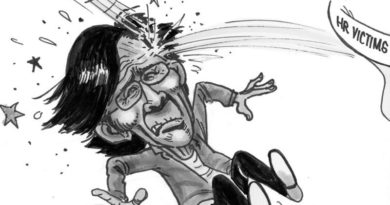OP ED COLUMN: OPINION ON PAGE ONE – GMA can still save DU30 from himself
THE vulgarization of Malacañang’s “information campaign” on “federalism” has diverted public attention from the illegitimacy of President Rodrigo Duterte’s federalism project, and allowed a sexy dancer from the Presidential Communications Operations Office to take the hit for — and the heat away from — the President. Yet all those who felt their sense of taste had been violated by the offensive burlesque on “pepedederalismo” sadly missed the point. The song and dance number certainly deserved censure for being objectively degrading, but the real outrage was coming not from the song and dance, but from DU30’s heedless attempt to ram through his federalism project, in violation of the Constitution and right reason. This is what should be censured before any vulgar song and dance number associated with it is.
Why is DU30 involved?
For the nth time it must be stated that the President has no official role to play in proposing any amendment to or revision of the Constitution. This is made more than abundantly clear in Article XVII (Amendments or Revisions) of the Constitution. Only the Congress, through a constituent assembly, or a constitutional convention, called by two-thirds of all the members of Congress, or by the electorate at the call of a majority of all the members of Congress, may propose revisions or amendments. The people may also propose direct amendments not oftener than once every five years, upon petition of at least 12 percent of the total number of registered voters, of which every legislative district is represented by at least three percent of the registered voters therein.
This is the only relevant provision of the Constitution. It provides no role for the President. But the President is the one at the top, center and front of the push toward federalism. He has created a constitutional consultative committee to draft a proposed constitution for a federal republic — at what cost to the Filipino taxpayers, we do not know — and the members of this committee continue to occupy public space and newspaper space even after they have submitted their draft to the President, which should have rendered their positions functus officio.
We need to hear the President, or at least one among his eminent legal advisers, beginning with former Supreme Court chief justice Reynato Puno, former Senate president Aquilino Pimentel Jr and other so-called luminaries, say that our reading of the Constitution is incorrect, and that the President is, in fact, empowered by the Constitution to intervene in proposing constitutional amendments and revisions. This requires no more than a simple declarative sentence, and yet not one of them has had the courage to say it.
Will they then declare that the President can do whatever he wants, and that nothing he does can ever be unconstitutional or illegal — to borrow an infamous quote from former US president Richard Nixon in his celebrated interview with the legendary David Frost? Not one of DU30’s defenders has had the courage to say so either.
So, we have the sorry spectacle of the entire nation trying to grapple with the issue of federalism at the behest of a president who has no right or duty or power to propose it to our people. And every political player who, by the sheer number of years alone has earned the right or duty to say that wrong is wrong, tries to pretend that nothing is happening to disturb the constitutional order. Or the intellectual order.
This is no federalism
Just because DU30 says he wants to convert the Philippine unitary state into a federal republic, even pedigreed intellectuals who can break down the most complicated and minute ideas have failed to note that the proposal involves an inherent and irrevocable contradiction.
Again for the nth time, it has to be pointed out that what DU30 is proposing is not federalism but balkanization.
Federalism requires putting together separate autonomous or independent or semi-autonomous or semi-independent territorial units (states, regions or provinces) into one federal whole; it never entails breaking up an integrated unitary whole into 18 different parts, in the hope of putting them back together again. No one can declare a circle a square, a camel a horse, and even the emperor’s horse a Roman consul. Words need to keep their own meanings, and DU30 is no Humpty Dumpty who can, by executive fiat, make words mean whatever he wants them to mean.
I have a sneaking suspicion that the authors of the draft federal constitution are not totally unaware of the contradiction, except that they do not have the heart to tell DU30 about it. Thus, there is no clear attempt to really define the structure of the proposed federal system in the draft document. I am not alone in reporting this observation. Some pro-DU30 commentators who are apparently reading the draft constitution for the first time have arrived at the same conclusion. They do not find the metes and bounds of the federal system, nor the political alchemy that will produce the system. More evident in the document are what appears to be initial preparations for a possible shift to a parliamentary system.
Making it work
Nor does the draft constitution contain anything to show how the component units of the proposed federation, with their additional layer of government, will support themselves, and how the central government itself will work, after a huge chunk of its traditional income is siphoned off to the component states or regions. Making the unitary system work, before any proposed redistribution of income among the component federal units occurs, is already a monumental problem for the center, as we are witnessing while the government tries to cope with a 5.7 percent inflation. Balkanization will make this problem worse.
Because of the self-contradictory elements in the proposed project, I have serious doubts it will work, even if those aware of its offenses to right reason and to the Constitution do not say one word about it, but pretend that the law and right reason are scrupulously being followed. DU30 has painted himself into a corner from which he can no longer back off. It is a question of ego or super ego: because of his serious narcissistic disorder he can no longer back off; someone will have to save him from the certain political catastrophe that is the only possible outcome of his rush to this ill-conceived system of government.
Arroyo’s role
This is where Speaker Gloria Macapagal Arroyo comes in. Without saying that DU30 has made any wrong moves, she could effectively help reset the direction of government simply by assuring the Senate that the House will work together with the former as an equal, in proposing constitutional change. By filing a resolution calling for separate voting by the Senate and the House of Representatives if ever they convene a constituent assembly, Arroyo has shown that she would like the two houses to work together as one, without the House trying to exploit its numerical superiority over the Senate.
This was a welcome departure from the position of the ousted Speaker, Pantaleon Alvarez, who at one time suggested that the House propose constitutional amendments by its lonesome, or with the members of the Senate sitting with the congressmen and voting together as one. In all previous Constitutions, Congress when exercising its constituent powers to propose constitutional amendments, always did so with the two Houses sitting together, but voting separately. Thus, the vote of the 24-member Senate carried as much weight as the vote of the 292-member House.
In the present Constitution, the 50-member constitutional commission failed to specify that whenever the Congress decides to propose constitutional amendments, the two Houses should sit together as one but vote separately to approve any proposal by three-fourths of all the members of each House. It was a plain oversight, which happened after the Concom decided toward the end of its deliberations to adopt a bicameral Congress, although all its discussions from the beginning were premised on a unicameral Congress.
Nevertheless, there is no way to interpret the present wording of the Constitution other than in favor of separate voting by the two Houses. Section 1 of Article XVII reads: “Any amendment to, or revision of, this Constitution may be proposed by: (1) The Congress, upon a vote of three-fourths of all its Members; or 2) A constitutional convention.”
The provision does not specify that the two Houses should sit as one. So, the presumption is that they do not have to sit together to propose amendments, in which case they have to vote separately. But they are not barred from sitting together as one, so they could decide to do so by concurrent resolution in order to exercise their constituent powers. This does not mean the much smaller Senate has to be absorbed by the much bigger House; the two Houses should sit together as equals.
Respect for the Senate
In filing that resolution on separate voting, Arroyo demonstrated full respect for the Senate. This was underscored by her instruction to the appropriate House committees to leave all matters related to any proposed constitutional amendment to the proposed constituent assembly (ConAss). This bodes well for the ConAss.
Under Arroyo’s joint leadership with Senate President Vicente Sotto 3rd, the ConAss could operate, and should operate, as an independent and “omnipotent” body, free to disregard DU30’s unconstitutional intervention, and free to discard the draft constitution which has no valid constitutional provenance. With the proper dose of intelligence and courage, the body could perhaps banish the bogus federalist temptation and work earnestly for a much-needed shift to parliamentary government.
 All photographs, news, editorials, opinions, information, data, others have been taken from the Internet ..aseanews.net | [email protected] |.For comments, Email to :D’Equalizer | [email protected] | Contributor
All photographs, news, editorials, opinions, information, data, others have been taken from the Internet ..aseanews.net | [email protected] |.For comments, Email to :D’Equalizer | [email protected] | Contributor









